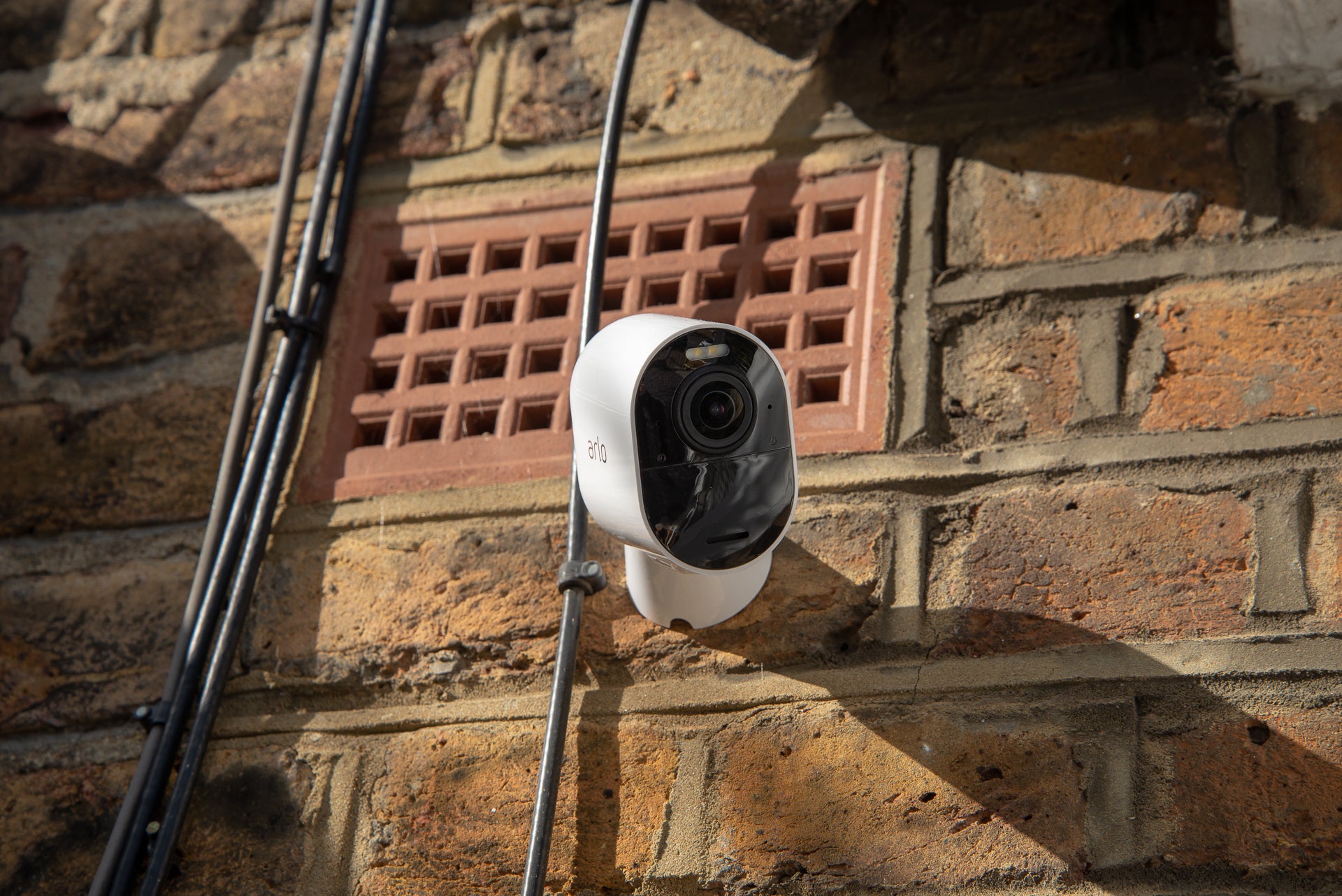Nest Doorbell (wired) Review
The new name for the Nest Hello, and still a great smart doorbell.
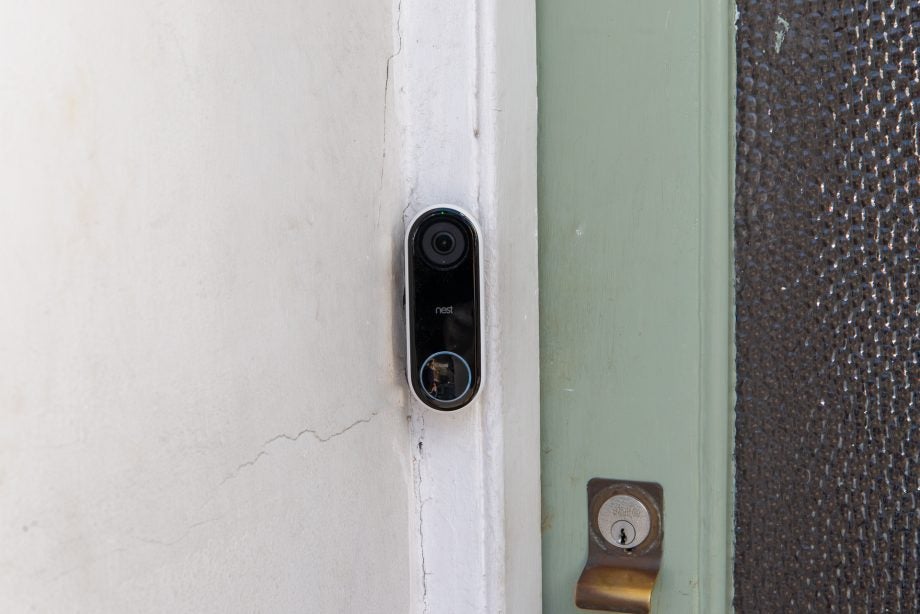

Verdict
It might be old but the Nest Doorbell (wired) (previously the Nest Hello) is still a great smart doorbell. In fact, in many ways it’s better than the newer battery-powered model, with a small body and higher resolution video. Provided you’re happy to pay for a Nest Aware subscription, this is the best doorbell that Google makes.
Pros
- Fast response
- Continuous recording option
- Can silence internal chime
- Facial recognition
Cons
- Installation a little tricky
- Few Quiet Time options
Availability
- UKRRP: £229
- USARRP: $229
- Canadaunavailable
- Australiaunavailable
Introduction
It might have a new name, the Nest Doorbell (wired) but this still an older product: the Nest Hello with a new name. This particular model sits alongside the newer Nest Doorbell (battery) giving you a choice of two doorbells.
While the newer model has some fancy offline recording and smarter object detection, it has lower resolution video and is larger. Here, provided you’re happy to pay for a Nest Aware subscription, you get most of the same features packed into a smaller doorbell. In my mind, that makes the Nest Doorbell (wired) the better product.
Design and installation
- Smart, slim and discreet design
- Fiddly wired-only design; professional installation is available to customers
Given that the newer battery-powered doorbell apes the older model’s design, the Nest Doorbell (wired) still looks great. The sleek black lozenge-shaped case will be right at home on the outside of your house. I found it smart enough to make it obvious that the Nest Doorbell (wired) is a doorbell and should, therefore, be pressed by guests; plain enough that it doesn’t ruin the exterior of your home.
At 117 x 43 x 26mm, the Nest Doorbell (wired) is considerably slimmer than the new model. This is largely because the doorbell is a wired-only product, so there’s no bulky battery to accommodate in the external casing.

The Nest Doorbell (wired)’s slimmer body makes the device a little easier to fit in some locations. I live in a Victorian house with narrow door frames, which didn’t easily accommodate the Ring Video Doorbell 4, and I ended up having to use the wedge adaptor, pointing the camera away from the garden path leading up to the door. The Nest Doorbell (wired) was positioned far easier, fitting onto the door frame, covering the full pathway to my front door.
In the box you’ll find a wedge to angle the doorbell, so you can get the field of view you need to cover your entryway. I used it to point the camera away from the side wall of the entry porch.
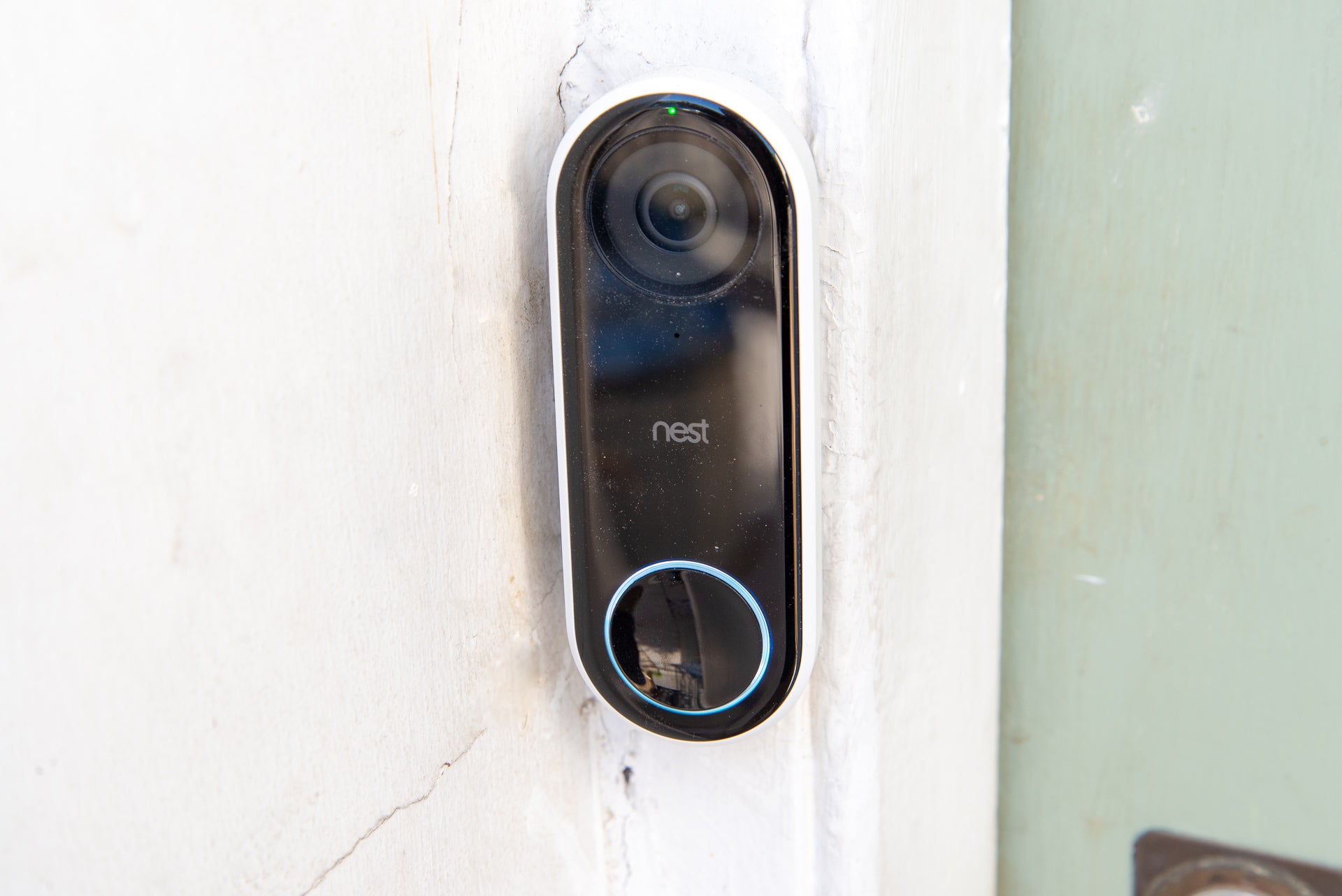
Since the Nest Doorbell (wired) is wired-only, installation isn’t as easy as with the new battery-powered model. For starters, you’ll need a transformer, and an existing one may not do the job; Nest requires a 16-to-24V AC transformer and many UK models are 12V. I had to have my transformer upgraded to get the doorbell installed. You’ll want an internal chime, too, although you can sound your Google Assistant speakers to alert you of people at the door.
Although a competent DIYer will be able to tackle the installation, a professional install may be the route worth taking or many. This will set you back £100 and will include connecting the doorbell and getting it working through the app. Nest can provide installation at the time of purchase, calling in an approved installer from across its network.
Note that you may need a replacement transformer and chime; the installation service doesn’t cover running new cabling, so expect to pay more if you don’t have a wired doorbell already.
Features
- Works well on the Nest app
- Needs a Nest Aware subscription to get the most features
- Clever facial recognition
While the Nest Doorbell (battery) is installed through the Google Home app, the Nest Doorbell (wired) is managed through the older Nest app, which is also home to other products in the range, including the Nest Thermostat.
It’s slightly frustrating that Google is splitting where its products sit, as you may end up flicking between two apps to use multiple products. For what it’s worth, I think that the Nest app is actually better than the Google one.
Hooking up the Nest Doorbell (wired) to your home network is fairly straightforward. In my case, Nest wanted to use my Nest Protect to help the camera join my home network. This should have required a simple tap of the Nest Protect’s main button, but the procedure failed the first time.
Annoyingly, Nest doesn’t provide an alternative installation method. In the end, I removed the Nest Protect from the wall (it’s in an outside office) and moved it to the front door, where the Nest Doorbell (wired) connected and paired to my home network. It would be far easier if Nest let you enter a wireless network manually should its installation fail.
The Nest Doorbell (wired) has built-in 802.11ac Wi-Fi, but UK regulations are such that only the 2.4GHz band is supported. Make sure, then, that you have a strong wireless connection at the front door.
Once the camera is connected, the Nest Doorbell (wired) can be monitored and controlled just like any other camera in the Nest app. Video is shot at a resolution of 1600 x 1200, and presented in portrait rather than landscape. Combined with the 160-degree lens, the video format is a good choice, since it means you capture a person’s entire body as they approach your front door.
As with other Nest cameras, you can set a schedule for when the camera is active, or have it turn on or off based on your location. You shouldn’t use location tracking and scheduling together, since it can have unpredictable results – the camera might turn off when you’re out.
However, with this type of product, it makes far more sense to leave the camera on permanently.

A press of the button on the pad outside will make your indoor chime ring, and you’ll receive a pop-up notification on your phone (and Apple Watch, if you have one). Answer it to have a conversation, just as you’d expect.
If you’re in a rush, there are three pre-defined speech options, which are read out by the Google Assistant through the doorbell’s speaker: “You can leave it”, “We’ll be right with you”, “We can’t answer the door”. All three are a little terse, but could be handy if you’re otherwise occupied, such as in a meeting at work.
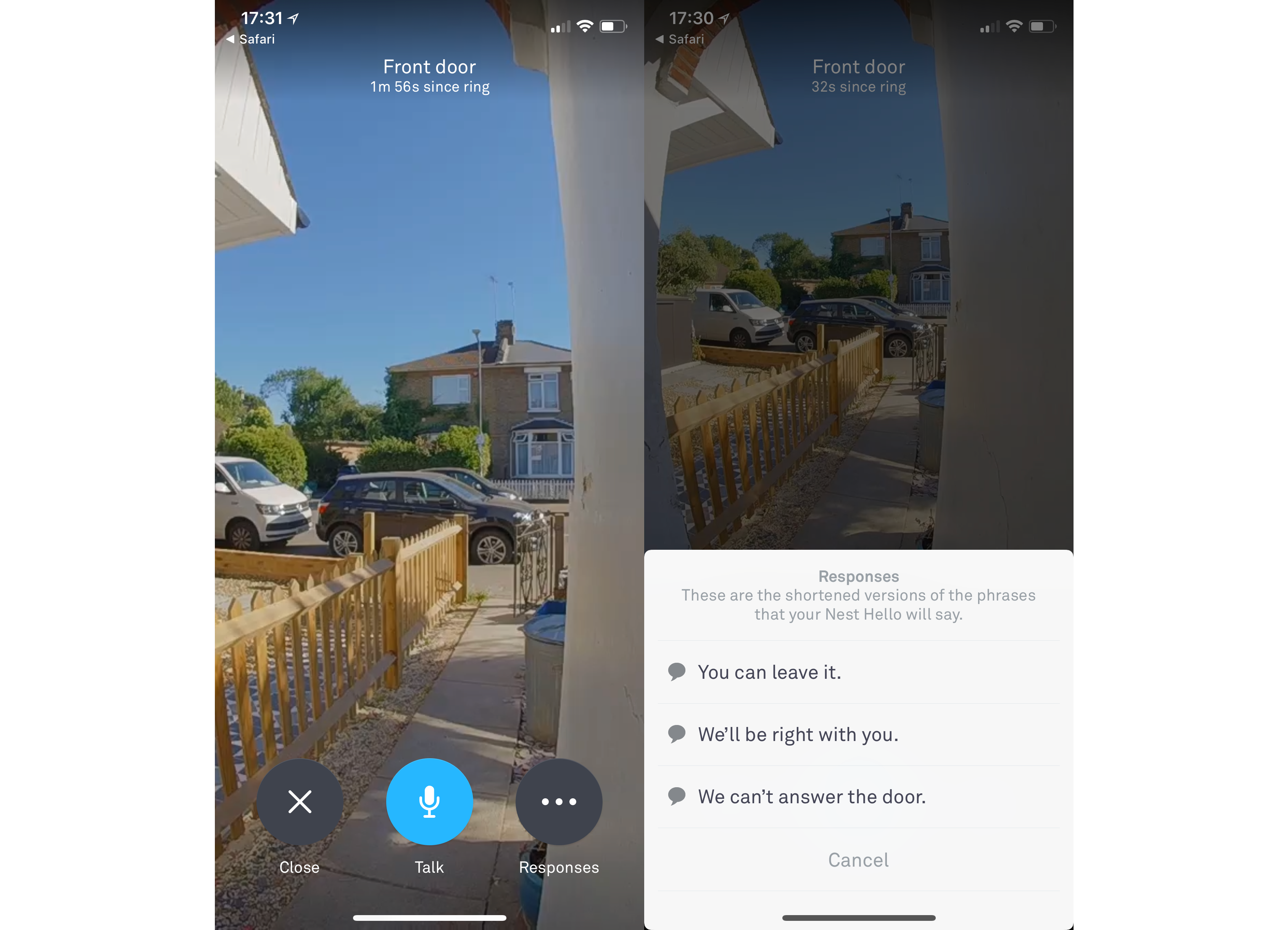
Nest uses a Chime connector, which sits between the doorbell and your indoor chime. It’s a neat addition, as it means that you can turn off your internal chime if you don’t want it to ring.
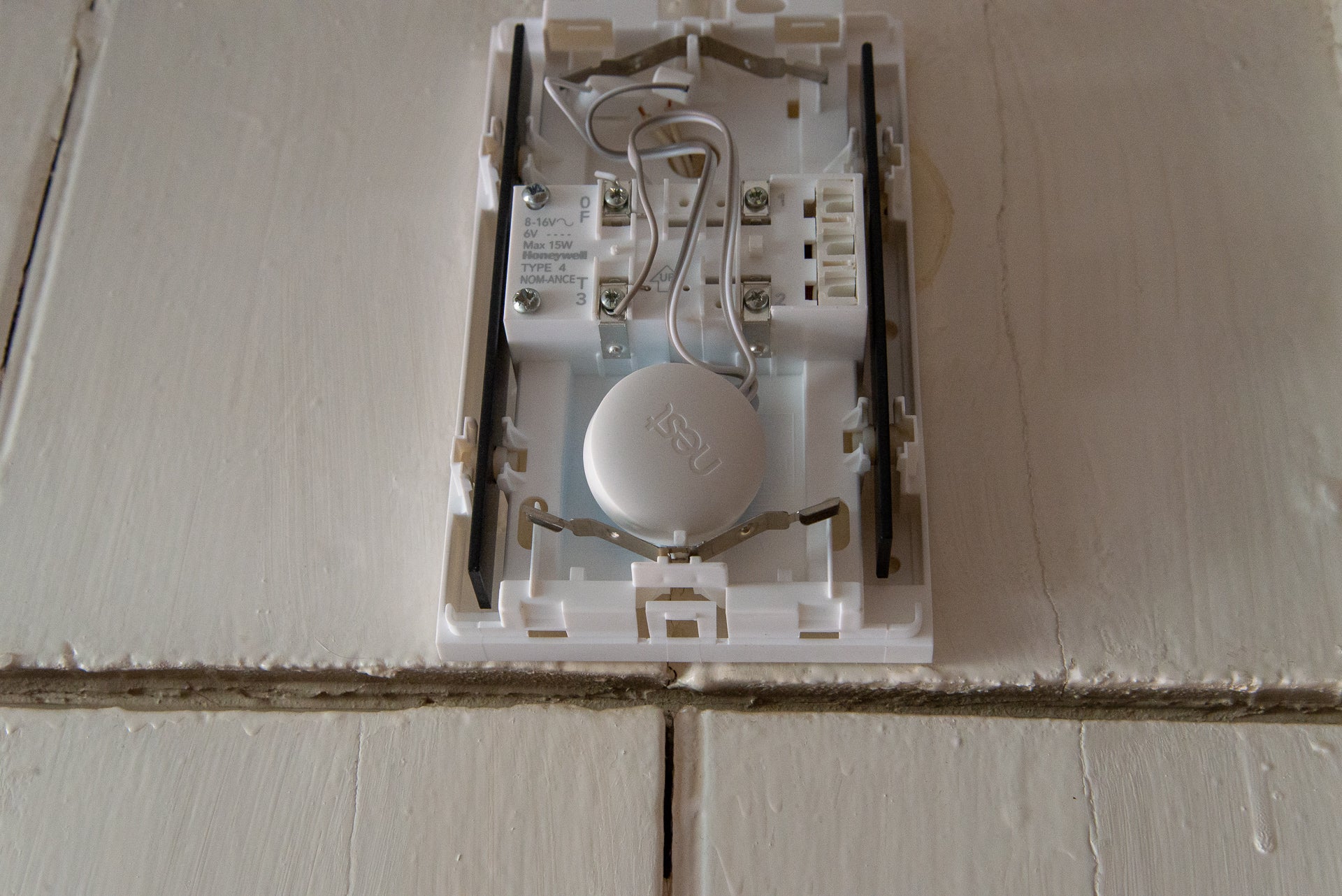
Using the Quiet Time feature in the app, you can also temporarily disable the chime for 30, 60 or 90 minutes. It’s a shame there’s no option to schedule Quiet Time for longer periods, such as overnight.
The internal chime ring is instant and as quick as using a traditional doorbell. Smartphone notifications can take up to 30 seconds to come through to your phone, although they generally hit with 10 seconds, and answering takes a few seconds more while the app connects. This is quicker than with the battery-powered Ring Video Doorbells and the new Nest Doorbell (battery), which take a while to wake up and connect to your wireless network, particularly on battery mode.
The high-quality microphone and external speaker make it easy and clear to have a chat with whoever is at your front door. Even better, since the video is in portrait mode, you can hold your phone normally to have a chat. 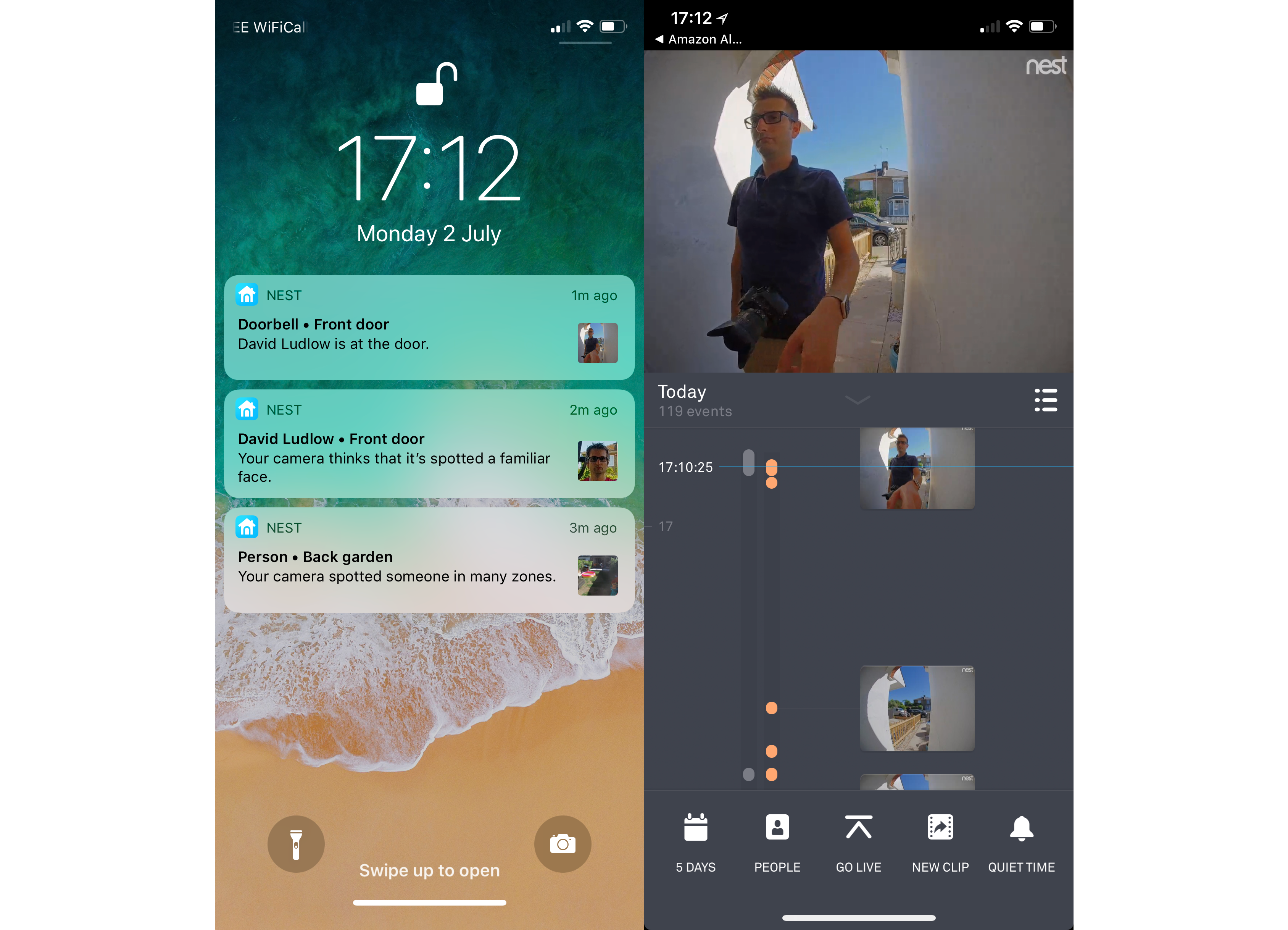
By default, the Nest Doorbell (wired) can recognise people, which you can use to configure motion alerts: you can toggle notifications for general motion or people. That’s a neat way to keep track of who goes up to your front door, but who may not ring the bell. Via the app, you can view thumbnails of previous activity, including motion and ring events.
Where this product really differs from the newer battery-powered model is that you really need a Nest Aware subscription to get the most out of it, as there’s no video recording built-in (the new battery doorbell records up to three hours of video offline with no subscription required). For the £5-a-month subscription, you get cover for all Nest cameras in your house with 30-days of event recording stored. Up to the more expensive plan and you can have continuous recording – a feature not available on the newer product.
With this turned on, you can scroll back through your video history and watch everything that was recorded.
The Nest App is fantastic at handling this, with its timeline view letting you scroll through everything effortlessly, highlighting events (motion and rings) so that they’re easy to find. Alternatively, the event view lets you just jump straight to an event, with thumbnails making it easy to find the one that you want. Nest is the gold standard for video history; no other security camera, let alone doorbell, comes close to the power on offer here. And, the Nest app does it quicker and with less effort than the same feature in the Google Home app.
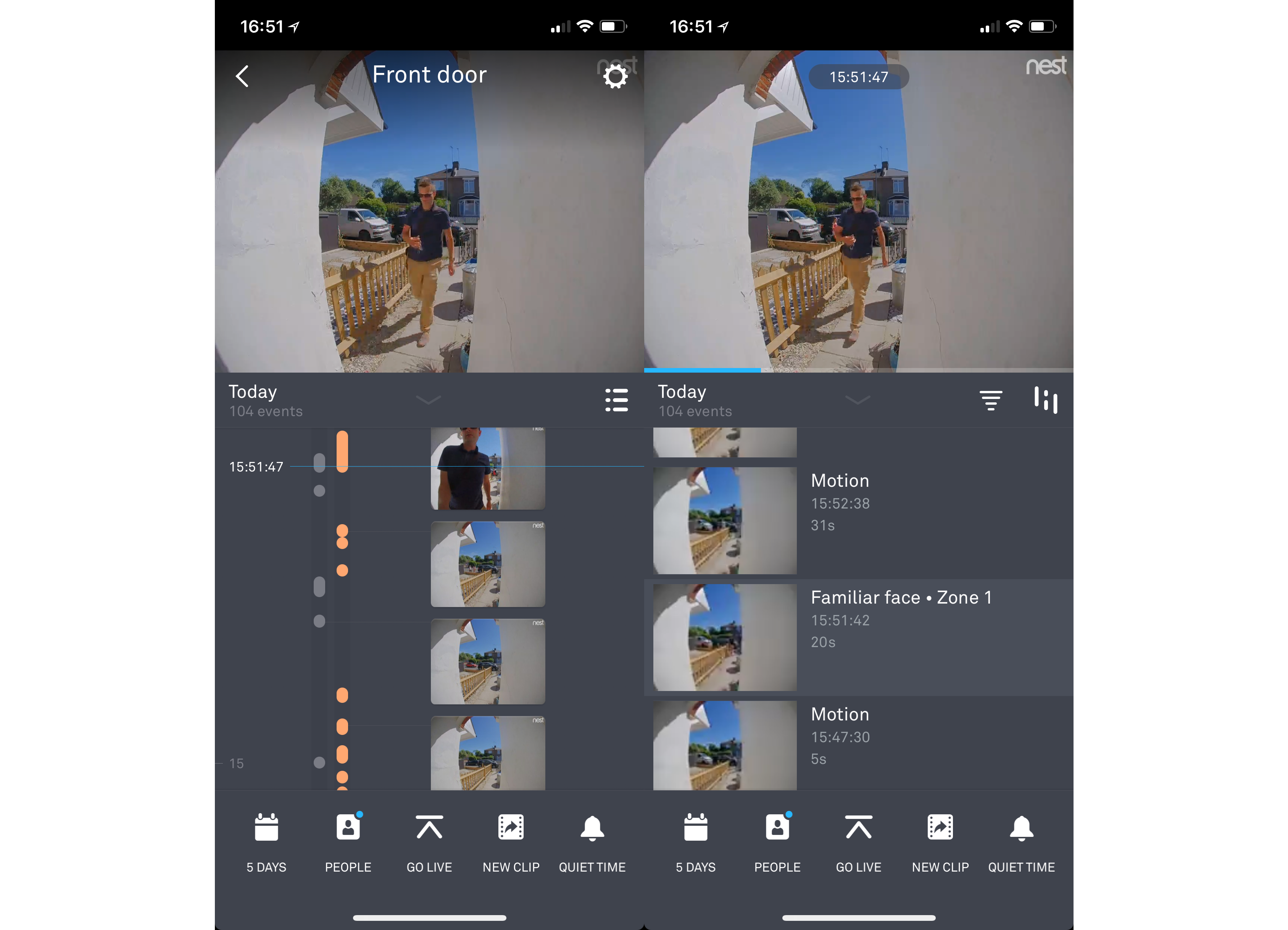
Nest Aware also adds a few additional features. Zones let you configure the part of the image you want to monitor, cutting down on false alerts by, say, ignoring a neighbour walking past. For each zone, you can toggle person and motion alerts individually. Nest also lets you digitally zoom and lock the zoom level, which can be a good way of cropping out a neighbour’s garden: under current UK law, you can record the street, but you should take into account neighbour’s privacy by not overtly recording their comings and goings.
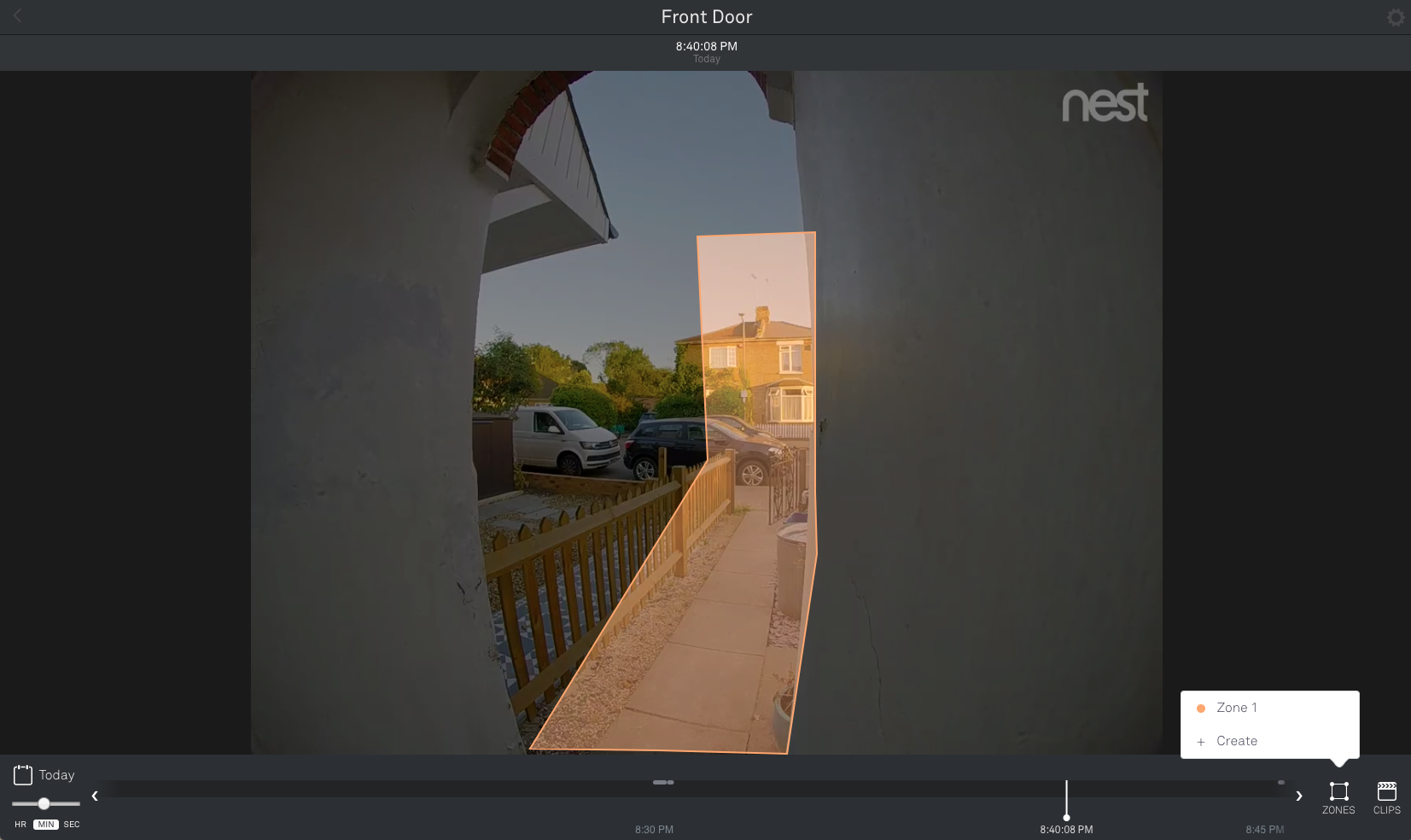
Facial recognition is also available. Any faces recognised by other cameras, such as the new Nest Cam (outdoor or indoor, battery) are carried over and automatically recognised by this doorbell. For new faces, you can tell the app which people you recognise, and which you don’t. This personalises the notifications you receive, with Nest telling you if there’s someone familiar or unfamiliar at the door. It’s a shame you can’t control alerts based on whether someone was recognised or not.
Via Nest Aware you also get package detection, so the doorbell will alert you when a courier turns up. You don’t get the animal and vehicle detection options that the new battery-powered doorbell has, though.
Facial recognition is really powerful, and the system gets better over time; the more it sees the same people. Mistakes can be made, however, and Nest can sometimes make two entries for the same person. These can be merged to improve detection in the future.
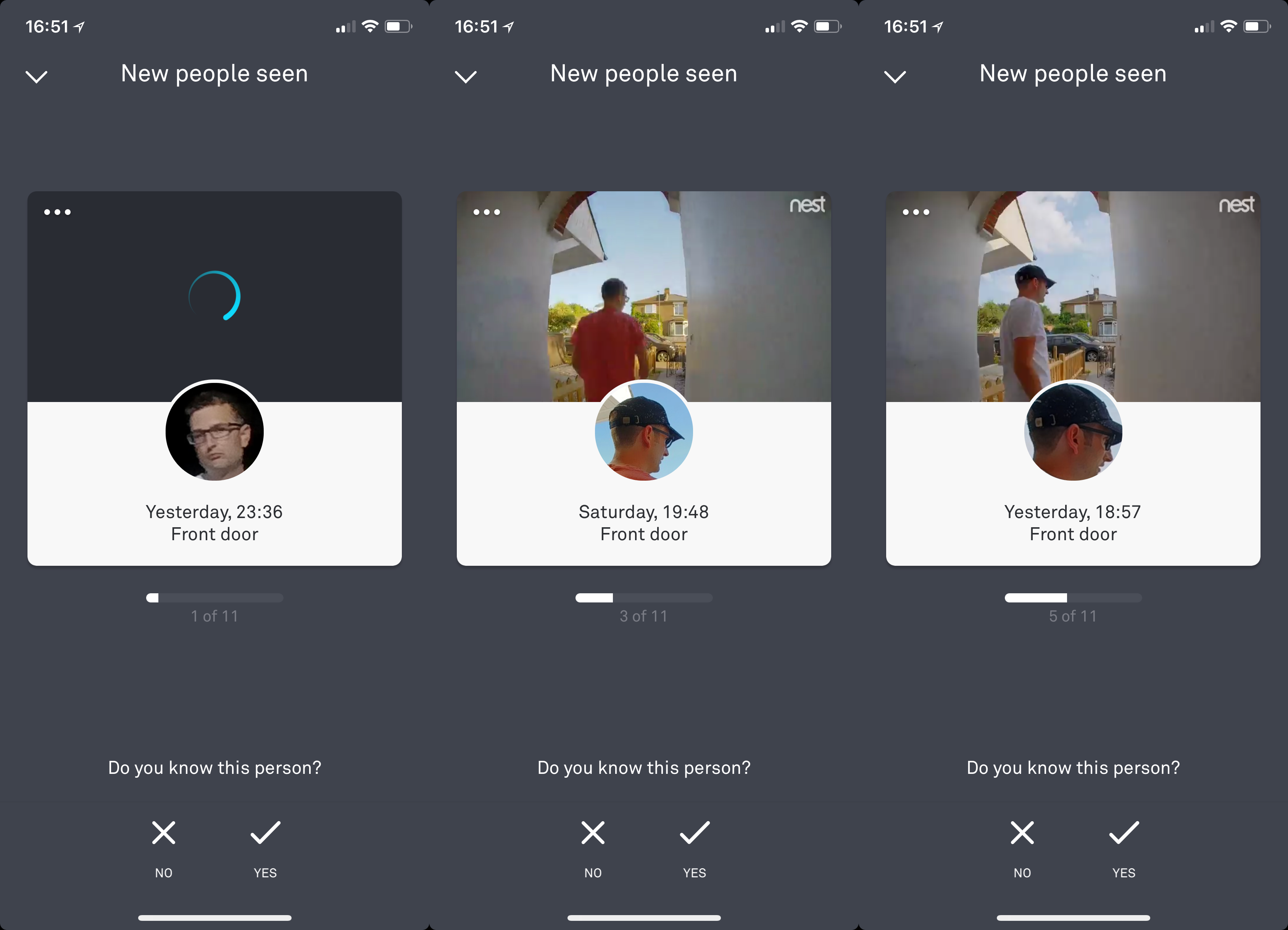
Nest Doorbell (wired) works with Google Assistant notifications. When the doorbell is pressed, your Nest Audio (or other Assistant-enabled devices) will announce that there’s someone at the door, so you know without having to be close to your phone or within earshot of your doorbell. If the camera has recognised someone, the notification tells you the name of the person who’s there, provided you’ve created a profile for them.
Control of Notifications can be toggled per device.
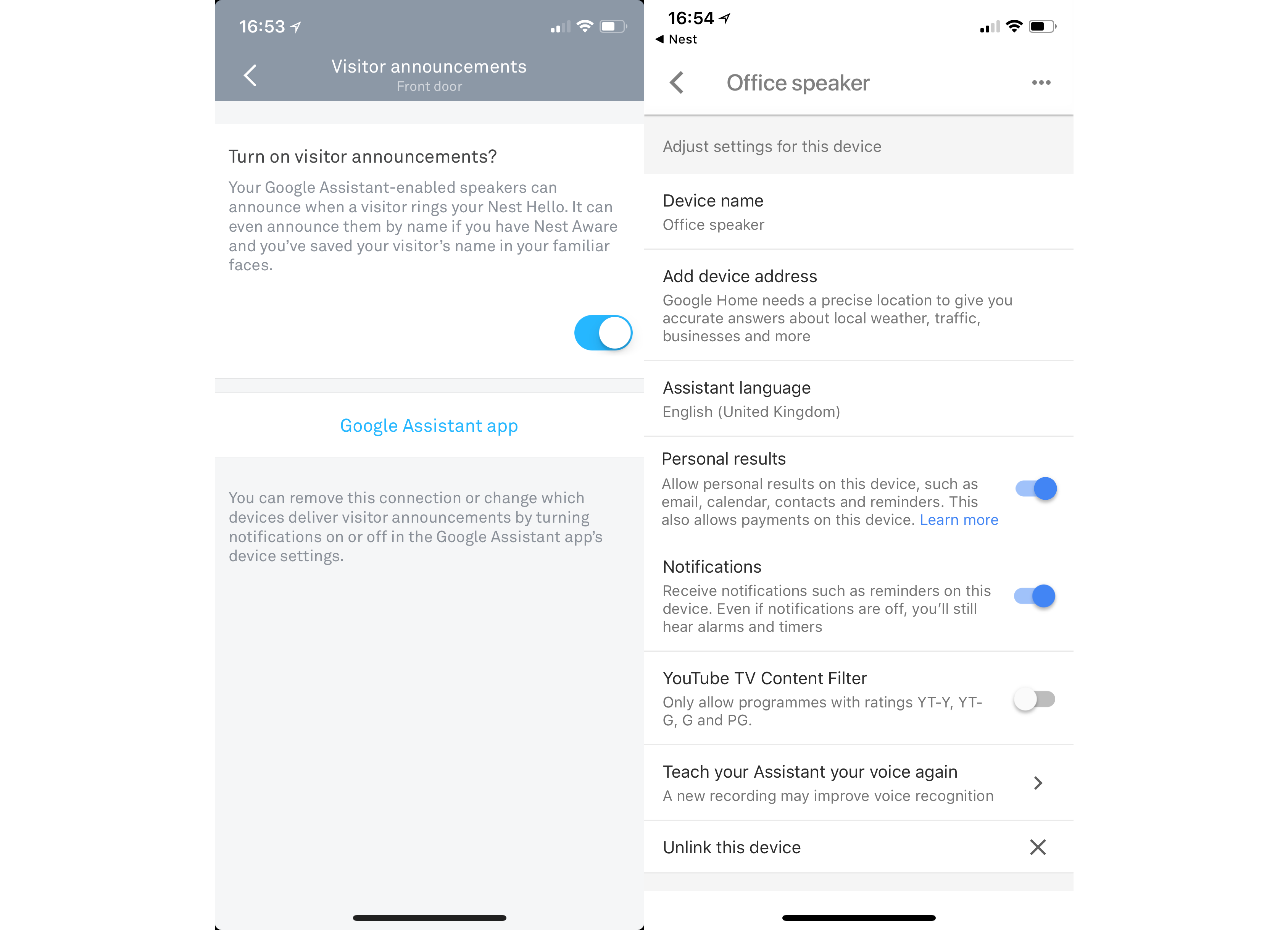
If you have a smart display, such as the Nest Hub or Lenovo Smart Display 10″, there’s another trick: the screen shows you a live feed from the Nest Doorbell (wired), alongside the voice notification, so you can see who’s at the door. Even better, you can now answer directly from the device. You may find that the feature’s not working for you and that when you tap answer you don’t get the video stream. The answer to this problem is to unlink your Nest account from the Google Home app and then add it again.
Once I’d done this, tapping the Talk button let me answer the front door and then have a conversation with whoever’s on the other side. I found that this was far quicker than having to pull out my phone, tap the notification and load the app to do the same thing, particularly as I have a Home Hub on my desk. Call quality will largely come down to the quality of the smart display that you’re using: the Nest Hub does a great job and was louder than using my iPhone.
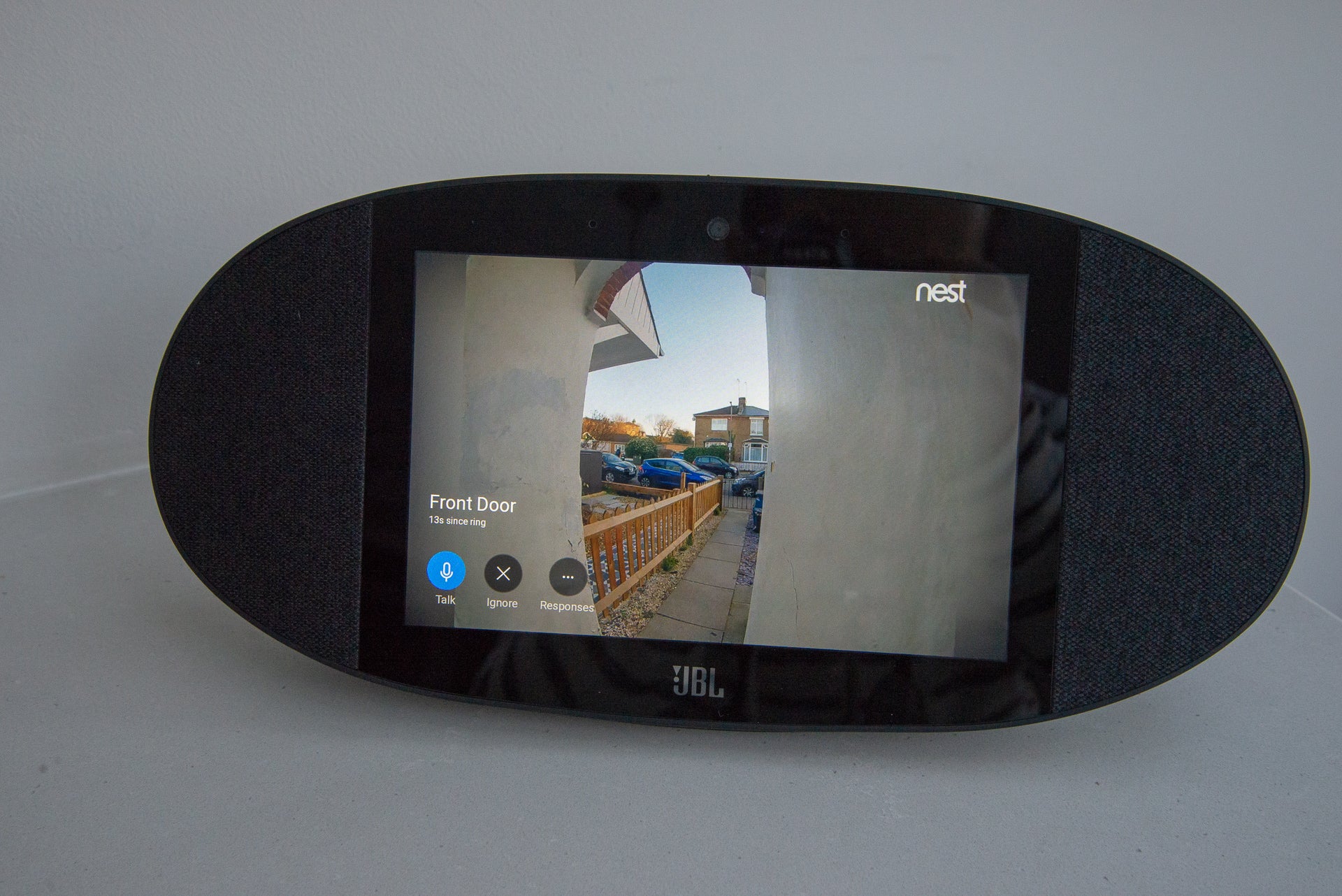
If you don’t want to talk to the person ringing your door, you can tap the Responses button and use one of the canned responses (‘You can leave it at the door’ and so on) instead. Again, doing this using a smart display is faster than using your phone.
It’s a shame that you can’t answer your doorbell through a smart speaker. Although this device will tell you that there’s someone at the door, it can’t open a two-way channel for a chat. It would make so much sense if you could say something like, ‘OK Google, answer the front door’.
Alexa support is available, although this is limited to viewing the camera feed on a video-enabled device, such as the Amazon Echo Show or Fire TV. Currently, there’s no option for announcements or answering a ring. Still, that’s one up on the Nest Doorbell (battery), which has no Alexa support at all.
Thanks to Google changing the way that you sign into Nest, the old IFTTT channel no longer works.
Video quality
- Very good picture quality overall, though it can struggle with fast-moving subjects
- Well exposed image
Nest uses HDR to deliver better-quality footage without blown-out or shadow areas obscuring details – and it works well. The footage during the day is brilliantly exposed across the entire picture.
Due to compression, faster-moving video loses a bit of detail, but you get a sharp image when someone is stood in front of your door waiting for you to answer. There’s very little noise in the image, and it’s easy to recognise individuals. Opt for the Ring Video Doorbell Pro 2 and you get more resolution and sharper picture, but the Nest Doorbell (wired) still stands up pretty well.
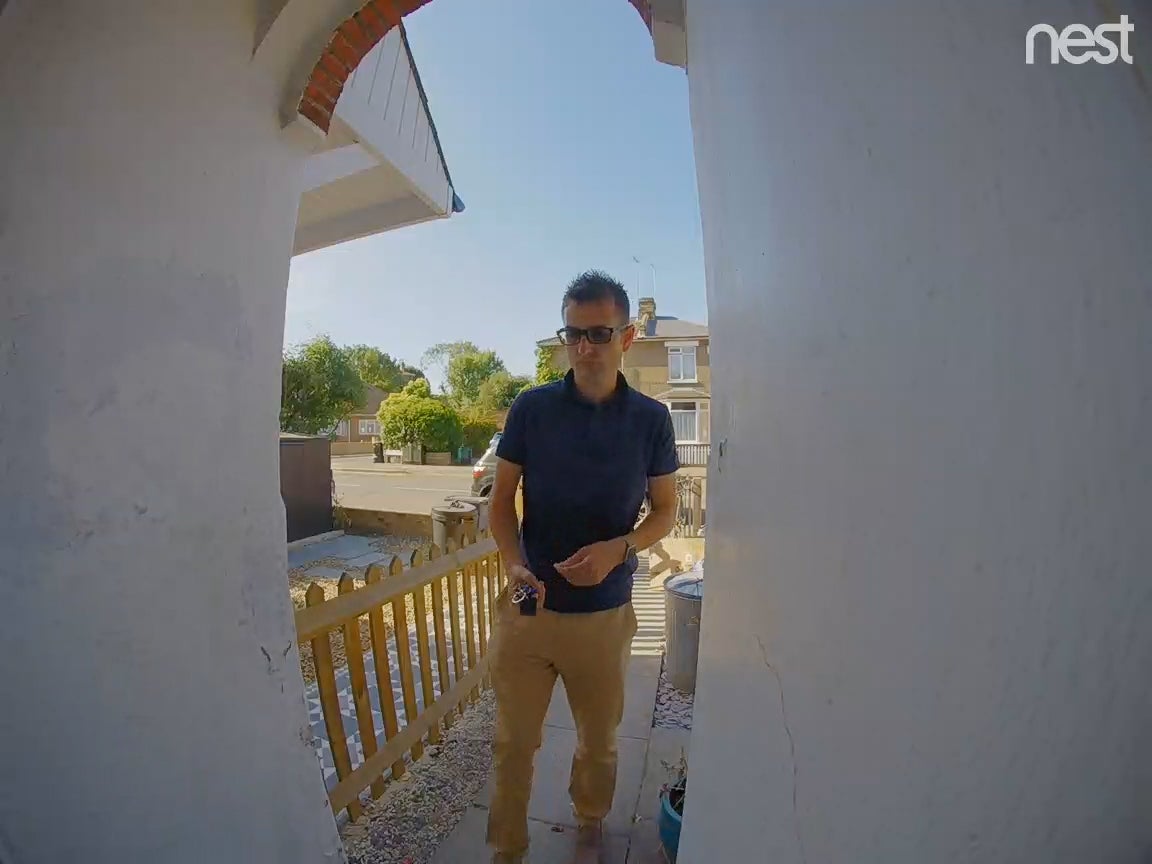
At night, the camera uses its IR LEDs. These were powerful enough to light up my entire front garden. Some detail is lost and the image becomes a bit noisier, but the same qualities shine through and you get a detailed image of anyone waiting outside of your home.
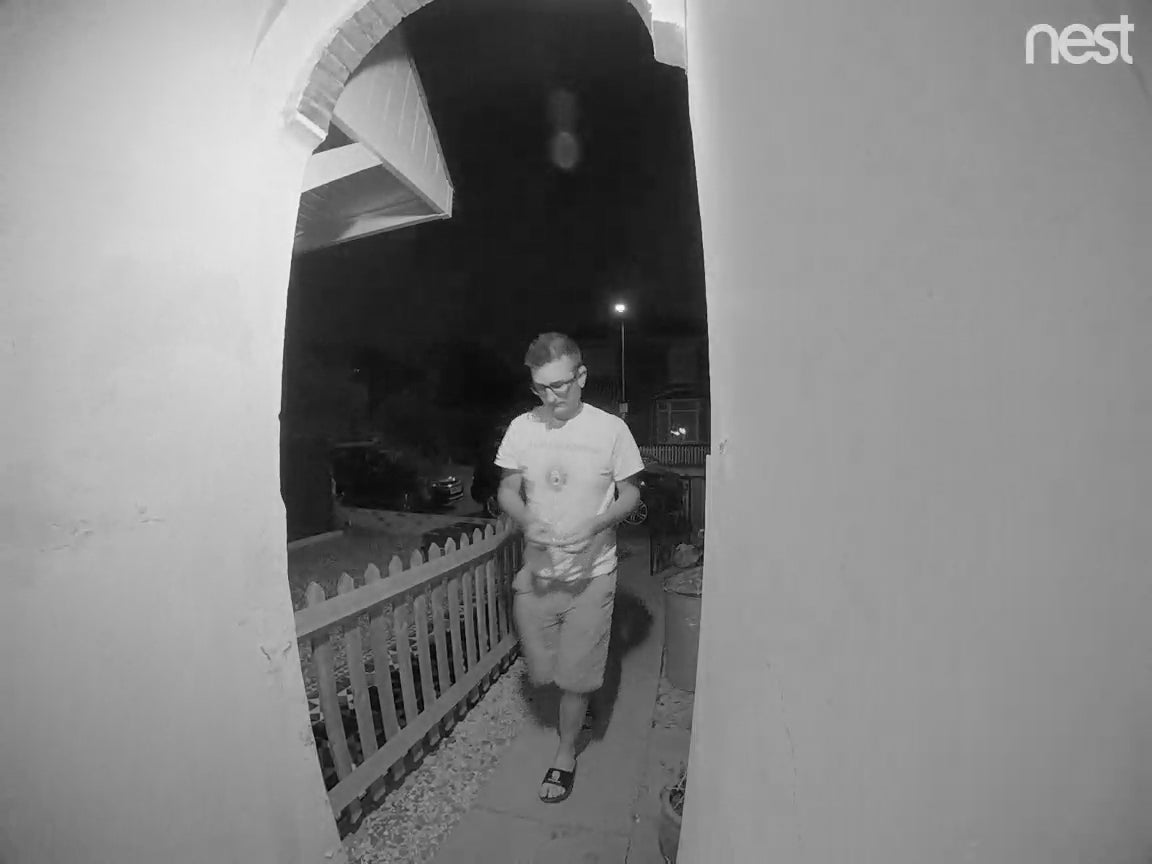
What’s, perhaps, a little surprising is that the Nest Doorbell (wired) has more resolution than the Nest Doorbell (battery). Compared side-by-side, the older product shoots better video.
Latest deals
Should you buy it?
If you’ve got Google Assistant smart speakers, this is a great doorbell to pair with them. It shoots higher-resolution video than the newer model, too.
If you’ve got Amazon Echo speakers, this isn’t a good choice. And, if you don’t want to pay a monthly subscription, the new doorbell may be better.
Final Thoughts
Without a battery, the Nest Hello isn’t quite as easy or as convenient to install as the Nest Doorbell (battery), which can be installed practically anywhere. It also loses out on the newer doorbell’s offline video recording and smarter object detection.
However, given that the Nest Doorbell (wired) is smaller than the newer model, responded faster in my tests and shoots better quality video, this is the doorbell I recommend for use with Google Assistant smart displays.
If you have Amazon Echo speakers, then the Ring Video Doorbell Pro 2 is the superior product.
How we test
Unlike other sites, we test every security camera we review thoroughly over an extended period of time. We use industry standard tests to compare features properly. We’ll always tell you what we find. We never, ever, accept money to review a product.
Find out more about how we test in our ethics policy.
Used as our main security camera for the review period
We test compatibility with the main smart systems (HomeKit, Alexa, Google Assistant, SmartThings, IFTTT and more) to see how easy each camera is to automate.
We take samples during the day and night to see how clear each camera’s video is.
FAQs
Yes it does, although you’ll only get basic alerts (motion and doorbell presses). If you want to record video and use facial recognition, you need a Nest Aware subscription.
You need a 24V transformer to use it.
You can ask Alexa to show you the video stream, but you don’t get alerts via Amazon’s smart speakers.

